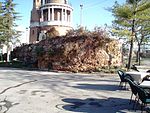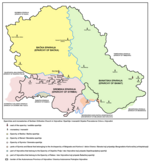Zemun Cemetery
Cemeteries in BelgradeEastern Orthodox cemeteriesEastern Orthodoxy in SerbiaIslam in SerbiaJewish cemeteries ... and 2 more
Muslim cemeteriesZemun

Zemun Cemetery is a public cemetery situated in Zemun on the Gardoš Hill. It is bounded by Cara Dušana Street, Nade Dimić Street, Sibinjanin Janka Street and Grobljanska Street, as well as with the staircase towards the Branka Radičevića Square, thus making the northwest boundary of the Old Core of Zemun. The cemetery is proclaimed the cultural monument.
Excerpt from the Wikipedia article Zemun Cemetery (License: CC BY-SA 3.0, Authors, Images).Zemun Cemetery
Grobljanska, Zemun Urban Municipality Zemun
Geographical coordinates (GPS) Address External links Nearby Places Show on map
Geographical coordinates (GPS)
| Latitude | Longitude |
|---|---|
| N 44.8485 ° | E 20.4075 ° |
Address
Земунско гробље
Grobljanska
11000 Zemun Urban Municipality, Zemun
Central Serbia, Serbia
Open on Google Maps










